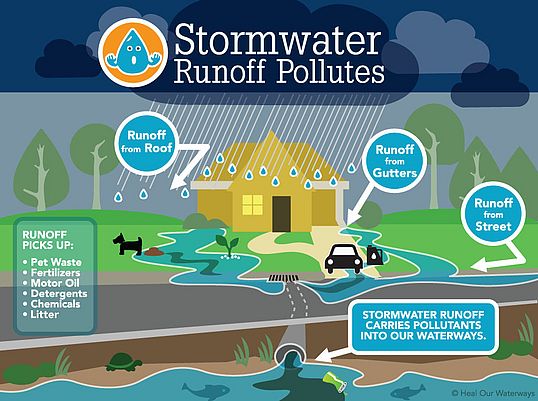
Small-scale Stormwater
Stormwater runoff starts at home and we all have a role to play in addressing Newfound largest threat. NLRA supports watershed homeowners, homeowner associations, businesses, and road associations working to limit their stormwater contribution.

Stopping Stormwater at the Source
The average house in the Newfound Watershed produces over 38,000 gallons of concentrated stormwater a year.
When not managed properly this water erodes soils, impacts infrastructure, and transports pollutants to waterways, damaging ecosystems downstream.
Limiting the amount of stormwater that leaves your property is the most effective approach to managing its environmental impact.
NLRA's Small-Scale Stormwater program helps homeowners keep pollution out of stormwater and keep stormwater from reaching Newfound Lake.
Here’s How We Can Help

Stormwater Response
NLRA staff are available to perform rapid assessments of stormwater damage following storm events. Rapid assessments look to determine the source of stormwater issues and quickly develop a course of action to stabilize the situation and prevent further pollution.

Stormwater Assessment
A stormwater assessment is an appointment-based service that looks at the whole of a property to identify sources of stormwater concentration and connect homeowners to DIY resources.

Stormwater Site Design
Ready to take the next step in managing stormwater? Work with NLRA staff to develop a custom landscape design addressing stormwater on your property. Site designs outline tailored stormwater solutions that can guide DIYers and landscape professionals to a lake-friendly landscape.
This service is free for current NLRA members that have completed a stormwater site assessment.

LakeSmart Certification
NLRA partners with NH LAKES to bring the LakeSmart program to the Newfound Watershed. LakeSmart is an evaluation and recognition program that is free, voluntary, and non-regulatory. It includes an evaluation process to determine how lake-friendly your property and activities are. The evaluation covers driveway and parking areas, structures and wastewater treatment systems, and yard and play areas. Take the LakeSmart survey

Project Assistance
Homeowners that have completed a stormwater site assessment are encouraged to apply for project assistance through NLRA's small-scale stormwater program. Stormwater projects utilize Newfound's AmeriCorps Watershed Stewards to help install stormwater control measures. Applications are assessed on environmental impact, project scope, and applicant need.
Small-Scale Stormwater Program Contact
Paul Pellissier | Conservation Program Manager | 603-727-4337 | Paul@NewfoundLake.org
5 Things That You Can Do Today to Prevent Stormwater Pollution

- DIRECT YOUR DOWNSPOUTS: When downspouts drain freely onto surrounding lawn or parking areas, they easily pick up household pollutants, damage gravel driveways, and erode soils. Downspouts should direct water to infiltration areas like drywells, rain barrels, or rain gardens.
- MAINTAIN A BUFFER: Vegetation along shorelines and surface drainages stop pollution from entering the lake. Buffers should be at least 25 feet wide and even wider on sloping ground.
- MOW LAWNS LESS: Go on, take a break, you deserve it! Letting your grass grow longer promotes root growth, meaning your grass will hold more water and require less fertilizer. When you do mow, keep the mower blade at least 3-inches off the ground and leave mulched clippings to decompose and act as a natural fertilizer.
- SAND AND SALT SPARINGLY: Chloride from de-icing salts accumulates in the environment year after year and can be toxic to aquatic organisms, even at low concentrations. Learn more about responsible salting here.
- CHECK YOUR SEPTIC: Septic systems do the dirty work of dealing with your waste but require regular maintenance to ensure they aren't a source of pollution. Maintenance schedules vary by usage and system design. Speak with a certified septic professional to set the right maintenance schedule for your system. More on maintaining a healthy septic here.

Learn more about how you can control stormwater by visiting NLRA's online resource library.